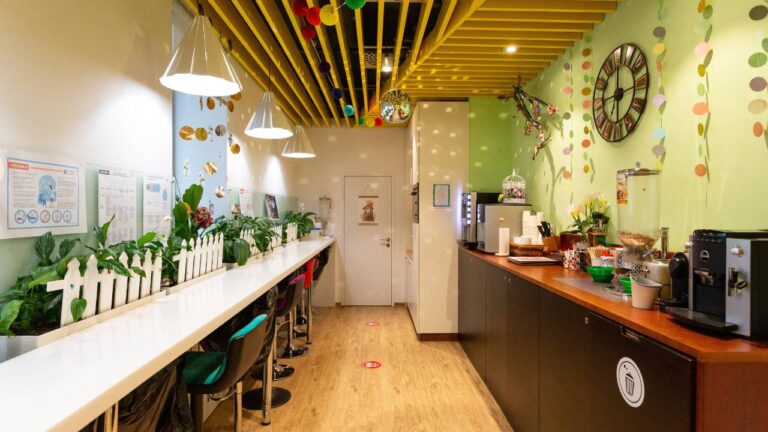In recent years, Irish businesses have paid growing attention to the wellbeing of their employees, recognising the importance of a healthy work-life balance for sustainable productivity and overall job satisfaction. One of the critical factors that can make a significant difference in this area is the office space design. In particular, office kitchens are taking centre stage as companies in Ireland seek to transform their workplaces into environments that support employee wellbeing.
This article will explore the various ways Irish businesses have transformed their office kitchens to achieve a positive impact on employee wellbeing. From ergonomic designs and carefully chosen amenities to creating collaborative spaces that foster communication and camaraderie, these innovative approaches are reshaping the traditional concept of an office kitchen and, in turn, promoting a more motivated and content workforce.
Emergence of Hybrid Working in Ireland
Remote Work and Hybrid Model During Covid-19
In Ireland, the Covid-19 pandemic has greatly affected the way people work. As a friendly nation that prioritises the wellbeing of its citizens, Ireland quickly adapted to remote work when the pandemic hit. Employees found themselves working from home to slow down the spread of the virus, and soon, hybrid working emerged as a popular alternative.
A hybrid working model combines the benefits of both remote work and in-office work, allowing employees to split their time between home and office. It quickly gained traction as it provided an optimal solution for maintaining social distancing while still enabling in-person collaboration.
Here are some key aspects that highlight the popularity of the hybrid model:
- Increased flexibility – Employees have the freedom to choose when and where they work.
- Reduced office space – Companies can downsize their office spaces, saving on costs.
- Greater work-life balance – Remote workers have more time for personal activities and family life.
Adaptability of Irish Workspaces
Along with the emergence of hybrid work in Ireland, workspaces had to adapt to accommodate this new way of working. One way to promote employee wellbeing in the hybrid model is by reimagining the office space, specifically focusing on office kitchens.
The office kitchen has transformed from a simple space for making tea and coffee to an essential hub for social interaction, networking, and collaboration. By placing more emphasis on office kitchens, companies are boosting employee engagement, productivity, and morale. They offer employees a comfortable space to relax, recharge, and connect with their colleagues.
Here is a brief overview of the changes observed in Irish office kitchens:
- Modern design – Office kitchens now feature open, spacious layouts, high-quality appliances, and ergonomic furniture.
- Collaborative spaces – Many office kitchens incorporate coworking spaces, allowing employees to work together in a more informal setting.
- Sustainable facilities – Driven by a passion for green living, Irish office kitchens include eco-friendly features such as recycling stations and energy-efficient appliances.
Role of Office Kitchens in Employee Wellbeing
Kitchen Design and Community

Office kitchens have evolved from merely being food storage spaces to destinations for employee socialisation and collaboration. Bespoke contemporary kitchens now prioritise a high-quality design that merges aesthetics and functionality, emphasising comfort and efficient usage. These welcoming spaces encourage employees to take breaks, engage in conversations, and build connections, fostering a sense of community within the workplace.
Well-designed office kitchens facilitate spontaneous interactions and bonding among employees, thereby promoting a collaborative and supportive work environment. Multi-functional spaces with a variety of seating options, natural lighting, and soothing colours contribute to the overall ambience and employee wellbeing.
Diet and Mental Health Correlation
A well-equipped office kitchen also plays a crucial role in supporting employees’ mental health by enabling them to maintain a healthier diet. It is widely acknowledged that food has a significant impact on people’s mood and cognitive function – a balanced diet is essential for emotional wellbeing and sustainable productivity. Access to a clean and efficient kitchen encourages employees to:
- Prepare their own meals, providing greater control over ingredient quality and nutritional content
- Consume more fruits, vegetables, and whole grains for better cognitive function, mood elevation, and stress reduction
- Maintain social relationships while eating, reducing feelings of isolation
The Economics of Office Kitchens
Cost-Benefit Analysis for Businesses
Investing in an office kitchen might raise concerns for businesses, as it requires allocating a portion of their budget for its installation, maintenance, and operation. However, the benefits of having a well-designed office kitchen should be carefully considered.
- Reduced time spent outside of the office – With a kitchen readily available, employees can spend less time leaving the premises for food and drinks, increasing productivity.
- Increased collaboration and teamwork – A well-equipped and welcoming kitchen encourages employees to gather, promoting interaction and facilitating communication among colleagues.
- Employee attraction and retention – Prospective and existing employees appreciate a comfortable office kitchen. In fact, this may contribute to their decision to work for, or remain with, a particular company.
Impact on Lease Terms and Commercial Property
Committing to an office space equipped with an adequate kitchen may have implications on the lease terms and commercial property aspects of the business.
- Space allocation – The establishment of a kitchen area demands some degree of space, which may affect the overall amount of floor space required for an office. This may result in a higher rent or lease rate.
- Customisation – If a tenant seeks to customise the kitchen facilities in a leased property, negotiations with the property owner may be necessary. This may entail additional clauses in the lease agreement.
- Responsibility for maintenance – It’s important to clarify whether the tenant or landlord is accountable for the maintenance and repairs of the kitchen facilities. This should be explicitly stated in the lease terms to ensure all parties understand their obligations.
Influence of Office Kitchens on Workplace Culture

Promoting Company Culture
Office kitchens play a significant role in cultivating a positive company culture. Providing a common area for employees to socialise, relax, and interact with their colleagues can help to foster bonds and build rapport among team members. In turn, this can develop camaraderie and stronger working relationships.
An inviting, well-equipped office kitchen also demonstrates the company’s commitment to employee well-being. A popular feature in modern office kitchens includes casual seating areas and aesthetics that encourage relaxation and conversation. Making these spaces accessible and appealing can greatly influence employee satisfaction and reinforce a positive workplace culture.
Enhancing Productivity and Creativity
One of the reasons to have an office kitchen is that such a space can boost productivity and creativity in numerous ways. Taking short breaks away from desks and workstations to grab a cup of tea or a snack allows employees to recharge, which can improve their focus and efficiency upon returning to their tasks.
Moreover, the office kitchen can be a source of informal brainstorming and idea-sharing. Casual chats while preparing lunch or waiting for the kettle to boil can lead to the exchange of thoughts and suggestions, thereby enhancing creativity and decision-making processes.
The influence of office kitchens on workplace culture is noteworthy. By promoting company culture and enhancing productivity and creativity, these communal spaces contribute to a positive and open work environment, ultimately benefiting both the employees and the organisation.
Assessing the Long-Term Trends
Office Space Demand Post-Pandemic
The Covid-19 pandemic brought about a rapid shift in working patterns. Many employees found themselves working from home, leading to widespread concerns about the future demand for office spaces. As businesses begin to return to a sense of normality, it’s clear that long-term trends are changing. The traditional 9-to-5 office day is evolving, and there is a growing need for flexible work spaces.
Companies are now looking for hybrid workspaces, where teams can work together in person, while also providing remote-working opportunities. This has led to a surge in the popularity of co-working spaces.
Some key trends in post-pandemic office space demand include:
- An increase in remote work: Many employees are now used to working from home and have adapted their homes to accommodate a home office setup.
- Growth of flexible workspaces: As businesses adjust to the new normal, flexible office spaces are becoming more popular, allowing employees to work in an environment that suits their needs.
- Adaptable office designs: Office spaces are now being redesigned to accommodate different working styles, enabling employees to find the perfect working environment.
Sustainability in Workspace Design
As concerns about climate change continue to grow, businesses are putting more emphasis on sustainable operations. This focus on reducing environmental impact has led to an increase in demand for greener workspace designs. There are several ways to make office kitchens and shared spaces more environmentally friendly, such as:
- Choosing energy-efficient appliances: Prioritise appliances with high energy-efficiency ratings to reduce electricity consumption.
- Encouraging reusable cups, bottles, and cutlery: By providing these items in the office kitchen, employees are discouraged from using single-use plastics.
- Opting for sustainable materials: When selecting furniture for your office kitchen, opt for materials that are sustainably sourced.
Moreover, new workspace designs often incorporate natural elements, known as biophilic design. These designs promote employee wellbeing by fostering a connection with nature. Some benefits of biophilic office design include:
- Improved air quality: Greenery in the office can help to purify the air, which aids in employee health and wellbeing.
- Reduced stress levels: A connection to nature can help to reduce stress levels for employees, fostering a more positive working environment.
- Enhanced productivity: Studies have shown that natural elements in the workspace can boost concentration, creativity, and overall work performance.
These long-term trends indicate a shift towards more flexible, environmentally friendly and employee-centric workspace designs. As businesses continue to adapt to new ways of working, office spaces are set to undergo significant transformations.
The Future of Work
Predicting the Evolution of Hybrid Workspaces

The future of work will increasingly revolve around hybrid workspaces, combining the benefits of both remote working and traditional office environments. As companies continue to adapt to changing employee needs, workspaces are being reimagined to better accommodate the trends of this new era.
One of the key aspects of these hybrid workspaces is flexibility. Employers are recognising the importance of offering choice to their employees, allowing them to work from their home offices, in the workplace, or a combination of both. This model not only helps employees maintain a healthy work-life balance but also enables businesses to save on facilities costs.
Remote working has given rise to virtual collaboration tools such as video conferencing, project management apps, and cloud-based file storage. These platforms facilitate a seamless work experience for employees, regardless of their location. As more teams continue to work remotely, we can expect these technologies to become even more sophisticated and integrated.
The Rise of Employee-Centric Office Amenities
While facilitating remote work is important, coworking spaces and offices will remain a key component in the hybrid work model. With that in mind, the role of the office must shift from a mere work location to a place that prioritises employee wellbeing. One example of this shift is the growing emphasis on designing office kitchens that promote wellness and social interaction.
- Healthier food options: Office kitchens will stock fresh fruits, snacks, and drinks that encourage employees to make better dietary choices.
- Comfortable social spaces: Office kitchens will boast comfortable seating and open spaces to encourage staff to interact, promoting a sense of camaraderie and collaboration.
Practical Guidance
Implementing Effective Office Kitchen Strategies
To create a positive impact on employee wellbeing, it’s crucial to implement effective office kitchen strategies. A well-designed and managed kitchen can significantly contribute to a more cohesive and resilient office culture. Here are some key factors to consider:
- Adaptability – Design your office kitchen to be flexible and versatile. This will ensure it can cater to various dietary preferences and support employees’ changing needs.
- Return to the office – As employees gradually return to the office after remote working, consider some upgrades or enhancements in the office kitchen to promote collaboration and improve their overall wellbeing.
- Accessibility – Ensure the kitchen has easy access to encourage employees to take breaks, grab a snack, or engage in brief interactions. A designated walkway can facilitate the flow of traffic and prevent congestion.
- Promote healthy eating – Provide facilities and storage solutions to encourage employees to prepare and store their meals at work. This can include adequate refrigerator space, microwave ovens, and utensils.
Building a Resilient Office Culture Through Facilities
A well-designed office kitchen can contribute to building a resilient and nurturing office culture. To achieve this, consider the following:
- Inclusivity – Create a comfortable and welcoming environment for all staff members, irrespective of their roles. This can foster a sense of belonging and camaraderie among colleagues.
- Encourage social interactions – Set up seating arrangements or communal tables to promote casual conversations and the exchange of ideas.
- Promote sustainability – Integrate environmentally-friendly practices into kitchen operations, such as recycling and using energy-efficient appliances.
- Celebrate diversity – Use the office kitchen as a hub to showcase and appreciate the various cultures, traditions, and backgrounds of employees, such as through themed food weeks or potluck events.
- Regular maintenance – Maintain a clean and hygienic kitchen environment to prevent the spread of germs and illnesses – this is particularly important as employees return to the office after working from home.
Conclusion
In Ireland, a notable shift in workspace design prioritises employee wellbeing, with the office kitchen emerging as a key contributor. This space fosters community, boosting satisfaction and productivity.
The positive impact extends beyond the workweek, providing a refreshing environment for employees. Companies investing in staff wellbeing cultivate resilient and cohesive teams, resulting in elevated satisfaction, stronger connections, and enhanced business performance.
